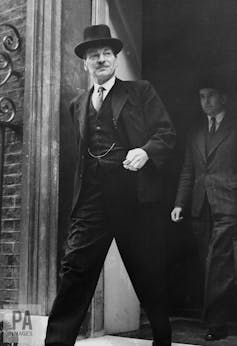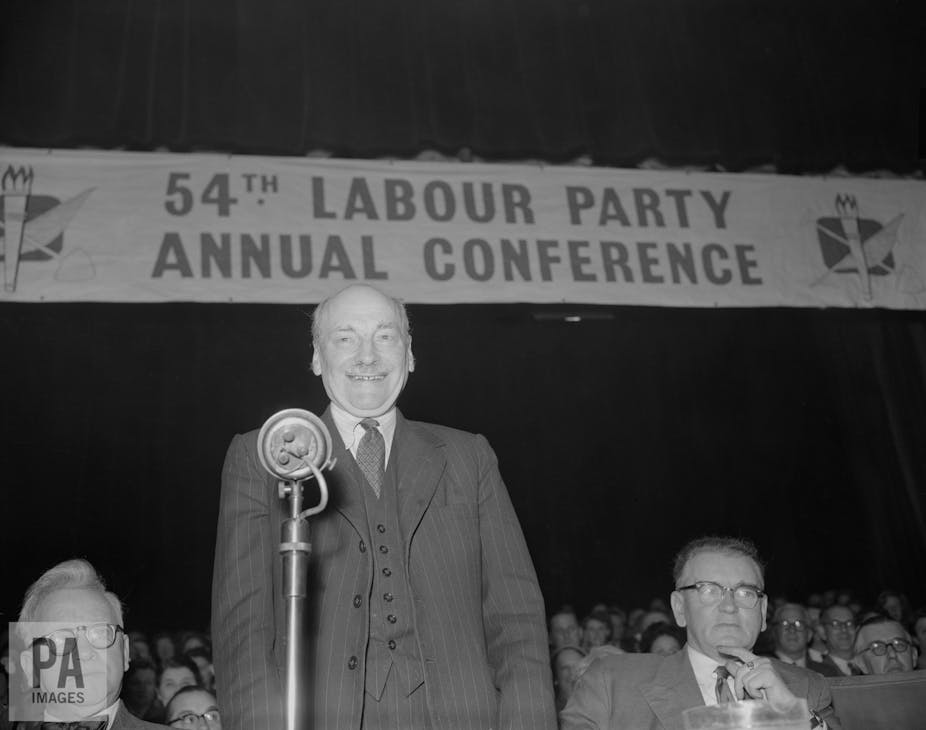Clement Attlee, the Labour Party’s longest serving leader and prime minister from 1945–1951, belongs in the top tier of Britain’s post-war leaders. Surveys for Britain’s best prime minister usually rate him first or second only to Margaret Thatcher. This is thanks to the considerable programme of reform he implemented during a time of fiscal austerity. His welfare state and National Health Service still stand as testament to his considerable achievements and his legacy, even now, is lauded across the political spectrum.
But there’s a side to Attlee that has been overlooked by historians: his intimate relationship with British intelligence and the significant part he played in the formation of Britain’s Cold War “secret state”, which laid the foundations for its current intelligence setup. The truth would leave many of Attlee’s admirers on the left today aghast.
Long seen as the shy, above-board socialist, Attlee has often been presented as someone far removed from the murky world of intelligence and security. While it’s relatively easy to find references to Churchill’s avid interest in secret intelligence, Attlee’s relationship with MI5, the Secret Intelligence Service (SIS) and GCHQ is almost undocumented. His biographers completely ignore the secret state altogether. Yet absence of evidence isn’t evidence of absence, as I found out working on this subject.
While definitely hard to research – this was, Attlee’s daughter-in-law, Countess Attlee, told me, the most secret subject for an already secret individual – releases of files from the Cabinet Office, Foreign & Commonwealth Office and the Security Service, in particular, offer new insight into his secret Cold War.
“Citizen Clem” should be seen as a vociferous Cold War warrior. A dedicated anti-communist, Attlee used MI5 to fight communism at home and on Labour’s own backbenches. While there were naturally moments of tension in the relationship, Attlee’s anti-communism chimed nicely with MI5’s surveillance of “fellow travellers” – members of the Communist Party of Great Britain (CPGB) and their secret associates.
Attlee enjoyed an excellent relationship with Percy Sillitoe, MI5’s post-war director general. He met the MI5 boss more often than any other post-war premier and even went on to write the foreword to Sillitoe’s memoir Cloak Without Dagger, published in 1955. Attlee was the first prime minister to visit MI5’s headquarters and, according to the diaries of its deputy director-general, Guy Liddell, was in “extremely good form, firing questions at everybody and telling stories”.
In Downing Street, Attlee would be briefed on Labour MPs suspected of being crypto-communists. Some suspicions, including those levelled at John Platts-Mills and Geoffrey Bing, were indeed correct, although MI5 appears to be have been wide of the mark with others.

Attlee was also an overseas Cold War warrior, as released material now makes clear. In 1948, responding to Soviet criticism, Britain launched a propaganda counter offensive, spearheaded by the Foreign Office’s Information Research Department (IRD). Attlee’s New Year’s broadcast showed to the Soviets that the gloves were finally off, with Moscow presented as pushing a “new form of imperialism – economic, political and strategic”. Soon afterwards, in a speech to MPs, Attlee attacked those in his own party who “shut their eyes to the absence of human rights when they look to Eastern Europe”.
Soviet skulduggery
But Attlee was more than just a propagandist. He could resort to more extreme measures in his Cold War crusade, even if details of his covert role only slowly emerged.
In late 2010, a Freedom of Information Request to the Foreign & Commonwealth Office yielded documents on Operation Valuable, an SIS plan to undermine Communist Albania.
In March 1949, with the plan fully worked out, details were sent to Downing Street for approval. Attlee’s handwritten response, reported back to the Foreign Office, certainly reveal his underhand side:
I should like an appreciation of Albanian personalities. Are they not possibly for sale?
Here was proof that Attlee, like Churchill before him, could use the hidden hand to further Britain’s overseas interests. His suggestion that the British bribe Albanian officials for information was not implemented but Operation Valuable did go ahead, with Attlee’s blessing. It ultimately failed to liberate Albania, and many lives were lost in the process.
Attlee approved further schemes to undermine the Soviet Bloc, though. The minutes from his secret “Committee on Communism” show the approval of “pinprick” operations and the underhand methods of black propaganda and subversion. In Germany and Austria, SIS would spread malicious information to smear Soviet officials, hoping they would defect, or, possibly, and far more grizzlier, be victims of the purges sweeping the Eastern Bloc at the time, while efforts were made to encourage a “spirit of resistance” among pro-Western groups in the satellite states.
Certainly, more revelations from the archives will appear as government departments release yet more material, detailing individual operations approved by Attlee from Downing Street. What’s already clear is that “Citizen Clem”, hero of the post-war welfare state and hardened “socialist”, should also be seen as a Cold War warrior, willing to use British intelligence to fight Soviet communism and maintain social democratic values.
Maybe now Attlee can be seen as the fully rounded politician that he was. The architect of Britain’s “New Jerusalem” was also the driving force behind Britain’s post-war “secret state”.

